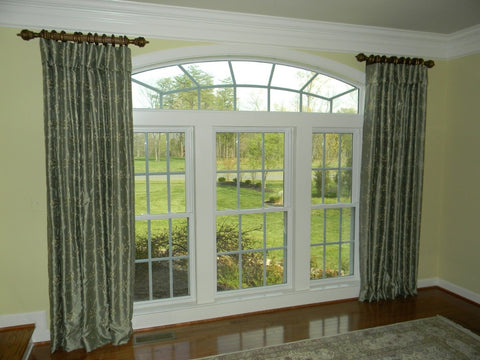How to Select Your Window Treatments
Window Treatments selection consists of deciding upon the following: window treatment style, drapery style, drapery type, desired length, and desired fullness. We’ve put together some guidelines that will help you with each category.
Window treatment style. Usually, window treatments can be thought of in two distinct categories: Stationary vs. Operational. Once again, the choice between the two depends on the look you desire and the available hardware choices. Everything is connected!
Stationary window treatments. These are treatments that are decorative only and designed to simply dress the window. You cannot close them for privacy or to block light.
Stationary panels are ideal if you have a great view that you would like to keep unobstructed or are nestled so that your window has adequate privacy already.

Operational window treatments. The opposite of stationary, these window treatments can be opened and closed. If you want more control over desired light or privacy, we would recommend this type.


- Drapery Panels can also be referred to as curtains when being used in more formal applications. Curtains can also be used to frame or dress the window in stationary/decorative panels or used as fully functional drapery that provides light filtration and/or privacy in single or double layers.
- Sheer Drapery: Because of its sheer nature (it can be seen through), we generally recommend installing a curtain rod that extends no more than 3 or 4 inches on either side of the window frame. If the rod extends more than this recommended width, you will be able to see too much wall filtering through the sheer curtain, creating an odd visual effect which makes appear too small for your window treatment.
- Standard drapery panels are usually 84 inches in length. Other readily available lengths include 63 inches, 96 inches, and 108 inches. Although some specialty retailers offer lengths of 120 inches which are perfect for new construction with higher ceiling heights.
- We suggest installing your panels with the top a few inches above the window glass. This will ensure, for example, if you chose pinch pleated draperies, that the backs of those pleats are not visible from outside the window.
- If you decide to do layered treatments (great choice), we recommend that the back layer should be about 1/2 inch shorter than the front so that any hems or other stitching elements are not visible underneath.
- Standard fullness is the width of the window in inches multiplied by 1.5 to 2 times.
- Full fullness is the width of the window in inches multiplied by 2.5 to 3 times. This fullness offers the most dramatic and luxurious effect
We offer several ready-made window treatment options from Softline and Menagerie on our website.
CWF PRO TIPS: Drapery choices and configurations can be endless.
- For an elegant, formal look, you may want to have some fabric puddling on the floor; or, you may want your window treatments to be above heating vents for safety reasons.

- For a full look, we recommend using sheers and unlined drapery which help create a fuller, billowy effect. The extra layers of fabric create more volume thus making the look appear more luxurious!
- Here is how we generally view the different types of draperies: pinch pleated draperies are chosen for a classic look, while grommet or back tab panels represent a more contemporary look. If you are going for a more casual look, tabbed would be your best bet.
- Tailored formal styles of window treatments that extend from floor to ceiling require a heavier curtain rod than lighter-weight curtains such as sheers and laces.
- Some rods, such as basic traverse rods or lockseam rods, are designed to be hidden by the window treatments.
- Generally, traverse curtain rods with hooks or decorative curtain rods with clip rings are best for window treatments you intend to open and close (aka operational window treatments.)
- Decorative rods alone or with rings, either rings with eyelets or rings with clips, are best for stationary window treatments.

